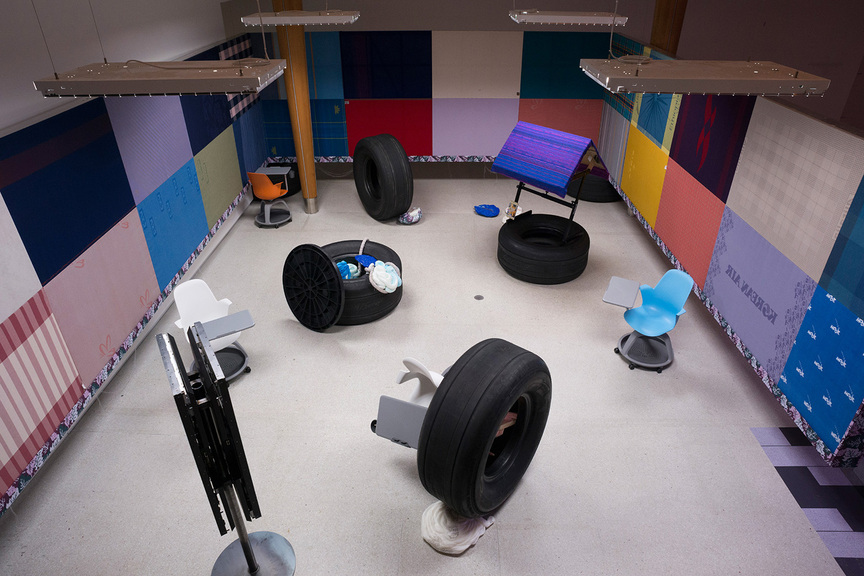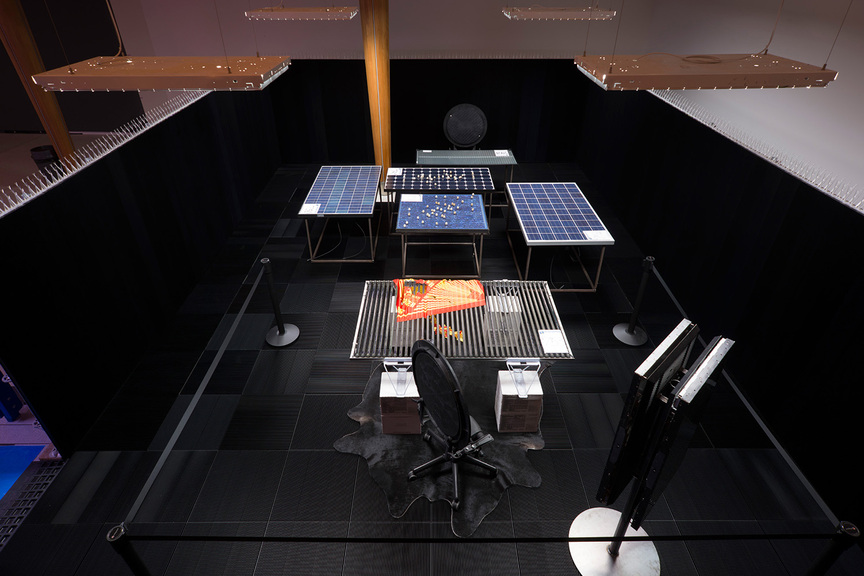-
From Current Issue
-
- Editor’s Letter Fire in the Heart
- Reviews I Gusti Ayu Kadek Murniasih
- Reviews 11th Seoul Mediacity Biennale: “One Escape at a Time”
- Dispatch Networked China
- One on One Monira Al Qadiri on Yukio Mishima
- Essays The rise of independent art spaces in pandemic-era Shanghai
- Features Tuan Andrew Nguyen
- Table of Contents
- Web Exclusives
- Archive
- Subscribe

R
E
V N
E
X
T
“Are all founders criminals of one sort or another?” notes a student who attended the Stanford University elective CS183, taught by Peter Thiel, the famed PayPal co-founder and supporter of Donald J. Trump. This sentiment resonates with Michael Stevenson’s new installation Serene Velocity in Practice: MC510/CS183 (2017) on exhibition at Auckland Art Gallery Toi o Tāmaki. In this showcase, the New Zealand-born, Berlin-based artist takes Thiel’s class and the fallout of innovation as its central focus. For Stevenson’s presentation, the gallery’s entire second floor was gutted of temporary walls, exposing a rough patchwork of plaster and paint from previous shows. This provided a warehouse-like environment to foreground his construction, consisting entirely of repurposed objects, which form two partitioned spaces conjoined by a roof-covered corridor.
The corridor and exhibition title reference Ernie Gehr’s acclaimed short film Serene Velocity (1970), which features a modernist university hallway that is animated by methodically executed, jumpy focal shifts, creating a sensation of undulating acceleration and retreat. The incessant perspective variations in Gehr’s film can be compared to the alternating pedagogical ideologies offered within Stevenson’s two interior spaces joined at opposite ends of the corridor. Each space resembles a type of classroom environment and is dedicated to now-defunct courses once offered by Californian educational institutions.
The first is devoted to MC510 (1982–86), a course offered at Fuller Theological Seminary and taught by pastor John Wimber and controversial theologian C. Peter Wagner, the former of whom is famed for founding the international Vineyard Movement, which influenced the entertainment format of evangelical churches. In these classes, Wimber taught faith-based healing of terminal health conditions and promoted the belief that demons are the cause for life’s ills.
Pointing out Wimber’s charlatanistic tendencies serves mainly to bring into question the validity of another paradigm-breaking West Coast figure—Peter Thiel—whose class CS183 is the topic of Stevenson’s second space. CS183 was a computer science elective through which Thiel extolled the virtues of the tech start-up industry as the most viable mechanism for progress. Underlying Thiel’s ideology is the insinuation that reliance on conventional technology will cause global collapse. This dovetails into allegations made in a 2017 article in The Guardian that Thiel essentially bought New Zealand citizenship to join “a growing band of wealthy Americans seeking a haven from a possible global apocalypse.”
Stevenson has scribed diagrams derived from MC510 and CS183 in liquid chalk pen on the surface of broken flat-screen monitors that illustrate Wimber’s and Thiel’s shared penchant for doomsday forecasting. The installation is also rife with less obvious innuendo pointing to the cultish, apocalyptic thoughts of Silicon Valley entrepreneurs. These are made through repurposed items relating to off-grid survivalist lifestyles and tax-evading globetrotting, such as aircraft tyres, solar panels, quail eggs (now proclaimed as a wonder food) and boxes of Soylent supplement, airline blankets that have no doubt swaddled digital nomads, and aluminum heat sink panels made to cool off the many servers that drive the tech industry. Each of these items embody a specific significance; once combined, they contribute to a larger narrative about the digitally savvy super rich seeking to attain immortality through the velocity of exponential innovation.
Returning to the reference of Gehr’s Serene Velocity is helpful in unpacking these meta-relationships. Serene Velocity’s pulsing repetition, cutting in and out of frames, asks us to examine the representation of institutional power and the formal limitations of abstraction. Through his expansive installation, Stevenson expands Gehr’s strategy by asking us to look and look again at the subjects and objects that he has amalgamated.
Serene Velocity in Practice: MC510/CS183 is a contextually generous installation that echoes the material footprint of trailblazers and alludes to an age that is barely sustaining its centripetal force of progress. For these reasons, the work has an unavoidably cold countenance that some might struggle to relate with, but this is precisely its strength.
Michael Stevenson’s “Serene Velocity in Practice: MC510/CS183” is on view at Auckland Art Gallery Toi o Tāmaki until February 6, 2018.
To read more of ArtAsiaPacific’s articles, visit our Digital Library.






